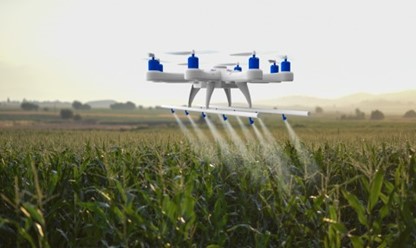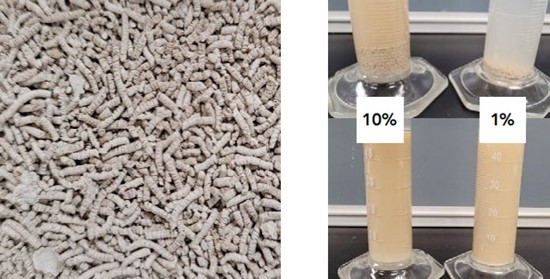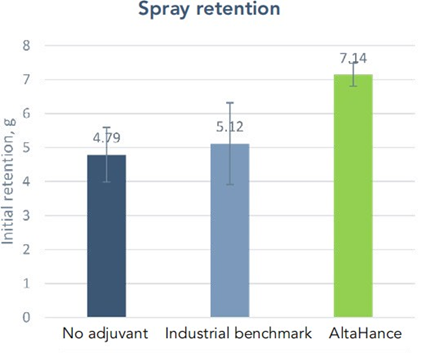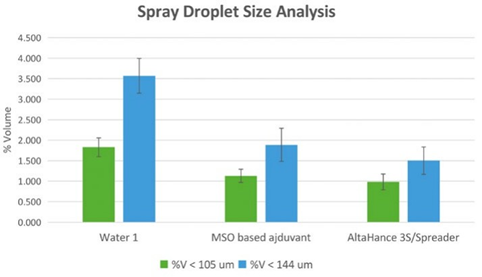Ingevity Dispersants and Adjuvants — Excellent Inerts for Biologicals and Chemicals ULV and UAV Formulations
The use of biological and chemical pesticides is one of the most recurrent and significant applications within agriculture; and in recent decades, spraying techniques have been developed to address the increased demand for more precise application methods. Robotics and spraying technologies like variable rate sprayers, unmanned aerial vehicle (UAV) sprayers, and electrostatic sprayers are growing in importance, increasing utilization rate of pesticides and biopesticides, reducing their residues, and providing significant cost-savings to the growers.
Ultra-low volume (ULV) spraying is gaining importance as one of the most common and advanced methods. ULV sprayers form small droplets (50 to 150 µL/m2), which render uniform coverage with low spray volumes. The objective of ULV sprayers is to reduce the fluid application rate, drift, and waste of chemicals while increasing insect and disease control. ULV sprayers can be vehicle mounted or aerial.
Although aerial spraying has been used since the middle of the 20th century, the innovation of UAV is thought to be one of the most important developments in the field of agricultural spraying and plant protection engineering. The idea of aerial spraying by means of UAV was first developed on the technology of unmanned helicopters that had been developed by Yamaha Corporation (Japan) for rice cultivation. Today, UAVs are known as the most advanced spraying technology that is helpful for effective and precision spraying. Aerial spraying using UAV has gained great interest worldwide and is getting more popular in Japan, India, China, and other countries. Unmanned aerial sprayers are potentially supportive in making the application process of agrochemicals safer for humans and the environment at the farm level. The use of UAVs is making plant production practices easier, especially on tall stalk crops such as maize, cotton, and water ponding crop such as rice but also orchards, tall trees, and vegetables.
Small-size UAV crop protection operations provide the advantages of a low flight altitude, flight velocity control, and good field adaptability, mainly for small fields and diversified crop planting zones. They can also be easily handled, transported, and used with sensor technology. In addition, small size drone sprayers provide efficient spray deposition on the target and reduce the airborne drift.
However, there are many challenges associated with drone applications. There is not enough research data on drone spraying performance and the comparison to ground sprayers and conventional aircraft available. Droplet deposition efficiency is one of the major concerns in all spraying methods, UAV included. Droplet size, weather conditions, and operational parameters of sprayers influence the spray coverage, absorption, and attachment to the target.
All of the above can be fine-tuned by advancing drone engineering and nozzle technology. Also, optimizing pesticide or fertilizer formulation performance by using high-quality interts in products specifically designed for drone spraying is another route to increase droplet deposition efficiency. Fewer acres are covered per hour of spraying compared to conventional spraying methods. Limited by the battery capacity, drone spraying lasts a very short time (5-15min with a full tank) and requires fast and frequent recharging between spray intervals. Growers need to take full advantage of each spray round with a limited amount of spray fluids to cover a field as much as possible. Adopting appropriate adjuvant technology can certainly optimize the spray and deposition pattern to achieve smaller droplets and higher coverage. However, smaller droplets evaporate faster, which might lead to poor penetration and absorption of systematic pesticides. In this case, building in inerts with humectancy can help retain moisture on leaf surface longer and help absorption. Accordingly, agitation is not a common feature to have in a small spray tank of any drone; having a spray product with high suspensibility and fast disintegration is very important, otherwise, the spray efficacy is compromised, and nozzle blockage is foreseen.
As stated above, formulation technology is a critical component in the efforts of expanding drone technology into agriculture crop protection and fertilization.
Ingevity provides biobased and biodegradable, high performing adjuvants and dispersants to produce high quality bio and chemical pesticides, with excellent fit into this fast-growing sector.
Figure 1. UAV ultra- low volume sprayer.

Based on kraftlignosulfonate technology, Ingevitys legacy Reax®, Polyfon® and Kraftsperse® are well known brand names in the marketplace for multi-actives and high active loading, both for chemical and biological (or combined) formulations, providing crystal growth inhibition and excellent UV protection, both in liquid and dry formulations, even at extremely low dispersant use rates. 2-5
Compared to hydraulic atomizers using tractor booms, the biggest limitation for UAVs is the limited volume it carries due to capacity constraints; hence, it is critical to employ high performing pesticides formulations which work well with much less water. The newly upgraded line, AltaBio™ is a step-up from the legacy dispersants with higher purity, larger molecular weight and better dispersing power.
AltaBio™ is designed specifically to address challenging biological formulations and hard-to- formulate conventional. Beauveria bassiana is an extremely hard to formulate, hydrophobic biological species. Using 1% AltaBio™ 200 as the only dispersant delivers granular product that can easily disintegrate in water at 1% or 10% dilution ratio (seen in Figure 2), meaning the water use quantity can be effectively cut down to only 1/10 of its original rate. With only 1/10 water being used in the diluted product, the resulting suspension has very similar particle size, and even slightly higher suspensibility comparing to the 1% dilution, shown in Table 1. In addition, Beauveria bassiana extruded water dispersible granules (WDG) with AltaBio™ 200 provides very high suspensibility (>80%) at only ¼ use rate of industrial benchmarks, including sulfite lignosulfonate and styrene acrylate copolymer and provides faster granular disintegration comparing to alternates.
Figure 2. Beauveria bassiana extruded WDG (left) and diluted formulations in 10% or 1% dilution.


Table 1. Beauveria bassiana extruded WDG: after dilution with water to 1% or 10% concentration.
With limited quantity being sprayed onto crops using UAV, one can only imagine the high importance of having fast surface wetting, less spray droplet rebounce, and better coverage. AltaHance™, a bio-based, green adjuvant line, offers a multitude of benefits to cover all these stringent requirements. By using a high-speed camera, the moment of a water droplet hitting a hydrophobic parafilm surface with or without the use of 0.5% of AltaHance™ as tank mix adjuvant was captured and compared. One can easily conclude that AltaHance™ provides fast wetting and noticeably reduces the droplet rebounce. As for spray retention on soybean, AltaHance™ provides 27% more spray retention compared to an industrial benchmark adjuvant product at the same use rate, 0.25%, and the difference is statistically significant, as seen in Figure 3.

Figure 3. Initial retention of AltaHance™ vs. Industrial benchmark adjuvant on soybean.
AltaHance™ also doesn’t negatively impact spray drift. Methylated soybean oil (MSO) was compared to AltaHance™ in terms of droplet size distribution at University of Dayton wind tunnel under the following test conditions: 15mph wind speed, standard nozzle set Teejet 8008 flat fan (coarse/very coarse), 35-40 psi (compliant to ASABE standard), 10 inches distance to measurement beam, and measurements in triplicates. Drift test result is shown in Figure 4.

Figure 4. Spray droplet size analysis by wind tunnel at University of Dayton.
As indicated in Figure 4, AltaHance™ performed comparable to slightly better than MSO, and both AltaHance™ and MSO positively impacted spray drift in comparison to water.
Another benefit AltaHance™ provides is excellent rainfastness at low use rate, for both in-can and tank mix applications, which effectively improves formulation efficacy. 6
In summary, as UAV/ULV technology gains worldwide popularity, the market demands high-quality pesticide products that perform well under various challenging conditions. As a leader in supplying bio-based, biodegradable green co-formulants, Ingevity is proud to be contributing to this revolutionary change.
Reference and Author– Team Ingevity


